While USDM Toyotas are going with the industrial trend of forcing higher prices onto consumers (ahem $40k RAV4), ChDM Toyotas show the true cost-cutting power of TNGA. All new TNGA models are very affordable and without being actual cheap shitboxes like Nissans.
You are using an out of date browser. It may not display this or other websites correctly.
You should upgrade or use an alternative browser.
You should upgrade or use an alternative browser.
12th Generation E120 Toyota Corolla Thread (Hatch, Sedan, Cross, GR)
- Thread starter Gecko
- Start date
Will1991
Moderator
- Messages
- 1,611
- Reactions
- 3,283
Doug is one of the biggest dumbasses to grace this Earth why would you take him seriously? There are so many better people to watch out there.
TFL agrees
flexus
Admirer
- Messages
- 532
- Reactions
- 893
I watched CarWow Corolla review and that's enough really.
TFL agrees
flexus
Admirer
- Messages
- 532
- Reactions
- 893

Toyota is finally bringing Corolla sedan and sports touring to Japan. Sales commence this autumn. Here is the link to special site:
トヨタ カローラ&カローラ ツーリング | NEW COROLLA&NEW COROLLA TOURING Japan model 2019 AUTUMN DEBUT! | トヨタ自動車WEBサイト
トヨタ カローラ&カローラ ツーリングを国内専用仕様にて2019年秋発売予定!
mikeavelli
Moderator
- Messages
- 7,490
- Reactions
- 16,632
I think it looks great in person particularly the SE. Crazy to see this is a Corolla...
MotorTrend even chooses the Corolla over the Mazda 3. I guess this really shows how this new generation vastly improved the Corolla...
"Compact cars are a diverse group, ranging from sporty and fun to comfortable and practical. Some entries even offer hatchback and wagon variants for consumers wanting maximum space in a small package. The 2020 Toyota Corolla and 2019 Mazda3 are the newest entries in an important (but dwindling) segment-we got our hands on both in sedan guise to see how well they stack up.
THE HEART AND BONES
Both the 2019 Mazda3 and 2020 Toyota Corolla ride on new architectures that are stiffer and more rigid than their predecessors. In a stunning turn of events, they traded rear suspensions; the Mazda3 now has a torsion beam, and the Corolla sports a multilink setup. In SE and XSE flavors, the Corolla also comes with wider tires than the Mazda3, further hinting at a sportier direction for Toyota's venerable compact car.
The 2019 Mazda3 comes exclusively with a 2.5-liter I-4 with 186 hp and 186 lb-ft of torque paired to a six-speed automatic. In addition to the carryover 1.8-liter I-4, Toyota offers a 2.0-liter unit with 169 hp and 151 lb-ft coupled to a CVT, like in our XSE tester. The Mazda3's extra power comes at the cost of fuel economy, though; it's EPA-rated at 27/36 mpg city/highway, trailing the Corolla's 31/38 mpg. Both cars are available with a six-speed manual, but only on the Mazda3 Premium hatchback and Corolla SE.
Now that we've gone over what's under the skin, let's hit the road.
ON THE DAILY GRIND
When subjected to the rigors of the daily commute and ever-changing road conditions, the 2019 Mazda3 and 2020 Toyota Corolla show their true colors. With its multilink rear suspension, the Corolla handily dispatches road imperfections and doesn't get upset unless you go over something sizable. The Mazda3 does the opposite. "It doesn't really absorb the bumps like it used to," MotorTrend en Español managing editor Miguel Cortina said. "There's a bit more roll, and a few times I felt like the rear end was dancing a bit on the twisty roads whenever I ran into a small bump." On the worst streets in Los Angeles, the Mazda3's suspension crashes violently, sending a nasty jolt into the cabin and causing a loud bang upon contact.
The Toyota Corolla's handling has improved significantly; it takes corners confidently and has good high-speed stability. Light and balanced steering makes maneuvering the Corolla through tight spaces a cinch. In comparison, the Mazda3's steering is stiff and accurate, which is great on the highway but tiresome in gridlock. Although the Mazda3 possesses better body control than the Corolla, it behaves like a comfort-oriented sedan; it understeers excessively, plows into corners when you ask it to hustle, and lacks the liveliness of its predecessors. Shockingly, the Mazda3's brakes didn't inspire confidence. "The pedal feel is so off that I almost had an 'oh s***' moment while trying to brake downhill," Cortina said. "You really have to press the pedal hard to stop."
Although the Mazda3 has more power than the Corolla, it's let down by a poorly calibrated transmission. "What's going on with this six-speed tranny?" Cortina asked. "It feels very jerky at low speeds, especially when starting from a stop." Shift times are also behind competitors, even in Sport mode when the gearbox responds quicker. Cortina also criticized the 2.5-liter I-4 for feeling like the 155-hp 2.0-liter unit from his previous-generation Mazda3.
In the Corolla, Toyota's 2.0-liter I-4 pairs well with the CVT, which makes good use of the available power. "The engine and transmission offered in higher trims makes such a huge difference," senior production editor Zach Gale said. "The CVT is responsive in the city and on the highway. I'm really impressed." Downsides? It's loud at full throttle, and some may notice the transitions between the physical first gear and the belt and pulleys.
LIVING SPACE
In addition to a comfortable drive, compact sedans must have usable interior and be a nice place to spend time during your commute. Squishy surfaces everywhere, a two-tone color scheme, and tactile buttons give the 2019 Mazda3's cabin a premium ambience. The Toyota Corolla feels nice, too—if you're sitting up front. Once you move to the back, the cost cutting becomes evident. "The door cards aren't bad, with blue stitching, silver trim, and piano black trim, but it still looks cheap compared to the Mazda," Gale said. Additionally, the Corolla also has more tire noise than the Mazda3 at highway speeds, likely due to its wider rubber and lack of sound deadening.
Both the Toyota Corolla and Mazda3 seat five, but if you regularly carry passengers, skip the latter. "The second row doesn't have enough legroom for my seating position, and I have less than an inch of free headroom," Cortina said. There's more space in the Corolla, especially in the rear, making it the superior carpooling sedan. Front passengers will feel more intimate because of the Corolla's dash cutting into your personal space. Trunk space is evenly matched, with the Corolla's measuring at 13.1 cubic feet versus the Mazda3's 13.2 cubic feet. The Mazda3 takes the cake for small item storage because of its large door pockets, center console bin, and deep mobile phone tray, all of which the Corolla lacks.
TECH GAMES
Neither Toyota nor Mazda have class-leading multimedia systems, and that remains true for the latest Corolla and Mazda3. Toyota's Entune 3.0 is new in name only; Cortina complained about the slow response times and graphics that looked a decade old. Gale liked how close the 8.0-inch touchscreen is to the driver because it's easier to see and reach. Unfortunately, it only comes with Apple CarPlay, forcing Android users to deal with the dated interface.
Mazda's new infotainment system gets brownie points for the standard 8.8-inch screen. However, its insistence on using a knob to control the interface drew mixed opinions. Gale didn't mind it as much because he got used to a similar setup in his old long-term Audi A4.
Everyone else disliked how long it took to execute simple tasks. "Although it's easy to control, changing a radio station can take forever," Cortina said. "If you want to go from channel 53 to 54, it takes a while unless you have both saved on your favorite presets." Having to control Android Auto and Apple CarPlay via a knob also makes them just as distracting as the native interface.
The Corolla beats the Mazda3 when it comes to active driver assistance technologies. Its lane keeping assist gently centers you and even takes mild turns at highway speeds. Mazda's version reacts so late that you've already crossed into the lane next to you before it realizes what's happened and jerks you back. Both cars' adaptive cruise control systems work in traffic; however, their distancing veers on the conservative side because there's enough space for someone to cut in between you and the vehicle ahead.
DID A SOUL SWAP JUST HAPPEN?
After a hard-fought battle, we declared our winner: the 2020 Toyota Corolla. How? Competitors have caught up to Mazda's once class-leading compact car. The Mazda3 has a plush interior and better build quality than the Toyota Corolla, but a finicky infotainment system, clunky powertrain, unrefined chassis, inconsistent active driver assistance tech, and a cramped interior let it down. The 2020 Toyota Corolla's fuel efficiency advantage, superior ride and handling balance, additional interior space, and a simpler multimedia interface make it the better all-around compact sedan. Extra power and a snazzy interior are nice, but they're not worth it if the rest of the vehicle doesn't deliver. Frankly, we'll take tire noise over a choppy ride and muted handling. Mazda, the most unlikely of rivals has put you on notice."
Link: https://www.motortrend.com/cars/toy...orolla-vs-2019-mazda3-comparison-test-review/
"Compact cars are a diverse group, ranging from sporty and fun to comfortable and practical. Some entries even offer hatchback and wagon variants for consumers wanting maximum space in a small package. The 2020 Toyota Corolla and 2019 Mazda3 are the newest entries in an important (but dwindling) segment-we got our hands on both in sedan guise to see how well they stack up.
THE HEART AND BONES
Both the 2019 Mazda3 and 2020 Toyota Corolla ride on new architectures that are stiffer and more rigid than their predecessors. In a stunning turn of events, they traded rear suspensions; the Mazda3 now has a torsion beam, and the Corolla sports a multilink setup. In SE and XSE flavors, the Corolla also comes with wider tires than the Mazda3, further hinting at a sportier direction for Toyota's venerable compact car.
The 2019 Mazda3 comes exclusively with a 2.5-liter I-4 with 186 hp and 186 lb-ft of torque paired to a six-speed automatic. In addition to the carryover 1.8-liter I-4, Toyota offers a 2.0-liter unit with 169 hp and 151 lb-ft coupled to a CVT, like in our XSE tester. The Mazda3's extra power comes at the cost of fuel economy, though; it's EPA-rated at 27/36 mpg city/highway, trailing the Corolla's 31/38 mpg. Both cars are available with a six-speed manual, but only on the Mazda3 Premium hatchback and Corolla SE.
Now that we've gone over what's under the skin, let's hit the road.
ON THE DAILY GRIND
When subjected to the rigors of the daily commute and ever-changing road conditions, the 2019 Mazda3 and 2020 Toyota Corolla show their true colors. With its multilink rear suspension, the Corolla handily dispatches road imperfections and doesn't get upset unless you go over something sizable. The Mazda3 does the opposite. "It doesn't really absorb the bumps like it used to," MotorTrend en Español managing editor Miguel Cortina said. "There's a bit more roll, and a few times I felt like the rear end was dancing a bit on the twisty roads whenever I ran into a small bump." On the worst streets in Los Angeles, the Mazda3's suspension crashes violently, sending a nasty jolt into the cabin and causing a loud bang upon contact.
The Toyota Corolla's handling has improved significantly; it takes corners confidently and has good high-speed stability. Light and balanced steering makes maneuvering the Corolla through tight spaces a cinch. In comparison, the Mazda3's steering is stiff and accurate, which is great on the highway but tiresome in gridlock. Although the Mazda3 possesses better body control than the Corolla, it behaves like a comfort-oriented sedan; it understeers excessively, plows into corners when you ask it to hustle, and lacks the liveliness of its predecessors. Shockingly, the Mazda3's brakes didn't inspire confidence. "The pedal feel is so off that I almost had an 'oh s***' moment while trying to brake downhill," Cortina said. "You really have to press the pedal hard to stop."
Although the Mazda3 has more power than the Corolla, it's let down by a poorly calibrated transmission. "What's going on with this six-speed tranny?" Cortina asked. "It feels very jerky at low speeds, especially when starting from a stop." Shift times are also behind competitors, even in Sport mode when the gearbox responds quicker. Cortina also criticized the 2.5-liter I-4 for feeling like the 155-hp 2.0-liter unit from his previous-generation Mazda3.
In the Corolla, Toyota's 2.0-liter I-4 pairs well with the CVT, which makes good use of the available power. "The engine and transmission offered in higher trims makes such a huge difference," senior production editor Zach Gale said. "The CVT is responsive in the city and on the highway. I'm really impressed." Downsides? It's loud at full throttle, and some may notice the transitions between the physical first gear and the belt and pulleys.
LIVING SPACE
In addition to a comfortable drive, compact sedans must have usable interior and be a nice place to spend time during your commute. Squishy surfaces everywhere, a two-tone color scheme, and tactile buttons give the 2019 Mazda3's cabin a premium ambience. The Toyota Corolla feels nice, too—if you're sitting up front. Once you move to the back, the cost cutting becomes evident. "The door cards aren't bad, with blue stitching, silver trim, and piano black trim, but it still looks cheap compared to the Mazda," Gale said. Additionally, the Corolla also has more tire noise than the Mazda3 at highway speeds, likely due to its wider rubber and lack of sound deadening.
Both the Toyota Corolla and Mazda3 seat five, but if you regularly carry passengers, skip the latter. "The second row doesn't have enough legroom for my seating position, and I have less than an inch of free headroom," Cortina said. There's more space in the Corolla, especially in the rear, making it the superior carpooling sedan. Front passengers will feel more intimate because of the Corolla's dash cutting into your personal space. Trunk space is evenly matched, with the Corolla's measuring at 13.1 cubic feet versus the Mazda3's 13.2 cubic feet. The Mazda3 takes the cake for small item storage because of its large door pockets, center console bin, and deep mobile phone tray, all of which the Corolla lacks.
TECH GAMES
Neither Toyota nor Mazda have class-leading multimedia systems, and that remains true for the latest Corolla and Mazda3. Toyota's Entune 3.0 is new in name only; Cortina complained about the slow response times and graphics that looked a decade old. Gale liked how close the 8.0-inch touchscreen is to the driver because it's easier to see and reach. Unfortunately, it only comes with Apple CarPlay, forcing Android users to deal with the dated interface.
Mazda's new infotainment system gets brownie points for the standard 8.8-inch screen. However, its insistence on using a knob to control the interface drew mixed opinions. Gale didn't mind it as much because he got used to a similar setup in his old long-term Audi A4.
Everyone else disliked how long it took to execute simple tasks. "Although it's easy to control, changing a radio station can take forever," Cortina said. "If you want to go from channel 53 to 54, it takes a while unless you have both saved on your favorite presets." Having to control Android Auto and Apple CarPlay via a knob also makes them just as distracting as the native interface.
The Corolla beats the Mazda3 when it comes to active driver assistance technologies. Its lane keeping assist gently centers you and even takes mild turns at highway speeds. Mazda's version reacts so late that you've already crossed into the lane next to you before it realizes what's happened and jerks you back. Both cars' adaptive cruise control systems work in traffic; however, their distancing veers on the conservative side because there's enough space for someone to cut in between you and the vehicle ahead.
DID A SOUL SWAP JUST HAPPEN?
After a hard-fought battle, we declared our winner: the 2020 Toyota Corolla. How? Competitors have caught up to Mazda's once class-leading compact car. The Mazda3 has a plush interior and better build quality than the Toyota Corolla, but a finicky infotainment system, clunky powertrain, unrefined chassis, inconsistent active driver assistance tech, and a cramped interior let it down. The 2020 Toyota Corolla's fuel efficiency advantage, superior ride and handling balance, additional interior space, and a simpler multimedia interface make it the better all-around compact sedan. Extra power and a snazzy interior are nice, but they're not worth it if the rest of the vehicle doesn't deliver. Frankly, we'll take tire noise over a choppy ride and muted handling. Mazda, the most unlikely of rivals has put you on notice."
Link: https://www.motortrend.com/cars/toy...orolla-vs-2019-mazda3-comparison-test-review/
That new torsion beam rear suspension is costing more in comfort than the interior material can compensate on the new 3. What a dumb move by Mazda.
Also this CVT with physical first gear is getting so much praise. It's getting so many converts, even among auto journalists who all hate CVTs with passion.
Also this CVT with physical first gear is getting so much praise. It's getting so many converts, even among auto journalists who all hate CVTs with passion.
F1 Silver Arrows
Expert
- Messages
- 2,566
- Reactions
- 4,171
MotorTrend even chooses the Corolla over the Mazda 3. I guess this really shows how this new generation vastly improved the Corolla...
"Compact cars are a diverse group, ranging from sporty and fun to comfortable and practical. Some entries even offer hatchback and wagon variants for consumers wanting maximum space in a small package. The 2020 Toyota Corolla and 2019 Mazda3 are the newest entries in an important (but dwindling) segment-we got our hands on both in sedan guise to see how well they stack up.
THE HEART AND BONES
Both the 2019 Mazda3 and 2020 Toyota Corolla ride on new architectures that are stiffer and more rigid than their predecessors. In a stunning turn of events, they traded rear suspensions; the Mazda3 now has a torsion beam, and the Corolla sports a multilink setup. In SE and XSE flavors, the Corolla also comes with wider tires than the Mazda3, further hinting at a sportier direction for Toyota's venerable compact car.
The 2019 Mazda3 comes exclusively with a 2.5-liter I-4 with 186 hp and 186 lb-ft of torque paired to a six-speed automatic. In addition to the carryover 1.8-liter I-4, Toyota offers a 2.0-liter unit with 169 hp and 151 lb-ft coupled to a CVT, like in our XSE tester. The Mazda3's extra power comes at the cost of fuel economy, though; it's EPA-rated at 27/36 mpg city/highway, trailing the Corolla's 31/38 mpg. Both cars are available with a six-speed manual, but only on the Mazda3 Premium hatchback and Corolla SE.
Now that we've gone over what's under the skin, let's hit the road.
ON THE DAILY GRIND
When subjected to the rigors of the daily commute and ever-changing road conditions, the 2019 Mazda3 and 2020 Toyota Corolla show their true colors. With its multilink rear suspension, the Corolla handily dispatches road imperfections and doesn't get upset unless you go over something sizable. The Mazda3 does the opposite. "It doesn't really absorb the bumps like it used to," MotorTrend en Español managing editor Miguel Cortina said. "There's a bit more roll, and a few times I felt like the rear end was dancing a bit on the twisty roads whenever I ran into a small bump." On the worst streets in Los Angeles, the Mazda3's suspension crashes violently, sending a nasty jolt into the cabin and causing a loud bang upon contact.
The Toyota Corolla's handling has improved significantly; it takes corners confidently and has good high-speed stability. Light and balanced steering makes maneuvering the Corolla through tight spaces a cinch. In comparison, the Mazda3's steering is stiff and accurate, which is great on the highway but tiresome in gridlock. Although the Mazda3 possesses better body control than the Corolla, it behaves like a comfort-oriented sedan; it understeers excessively, plows into corners when you ask it to hustle, and lacks the liveliness of its predecessors. Shockingly, the Mazda3's brakes didn't inspire confidence. "The pedal feel is so off that I almost had an 'oh s***' moment while trying to brake downhill," Cortina said. "You really have to press the pedal hard to stop."
Although the Mazda3 has more power than the Corolla, it's let down by a poorly calibrated transmission. "What's going on with this six-speed tranny?" Cortina asked. "It feels very jerky at low speeds, especially when starting from a stop." Shift times are also behind competitors, even in Sport mode when the gearbox responds quicker. Cortina also criticized the 2.5-liter I-4 for feeling like the 155-hp 2.0-liter unit from his previous-generation Mazda3.
In the Corolla, Toyota's 2.0-liter I-4 pairs well with the CVT, which makes good use of the available power. "The engine and transmission offered in higher trims makes such a huge difference," senior production editor Zach Gale said. "The CVT is responsive in the city and on the highway. I'm really impressed." Downsides? It's loud at full throttle, and some may notice the transitions between the physical first gear and the belt and pulleys.
LIVING SPACE
In addition to a comfortable drive, compact sedans must have usable interior and be a nice place to spend time during your commute. Squishy surfaces everywhere, a two-tone color scheme, and tactile buttons give the 2019 Mazda3's cabin a premium ambience. The Toyota Corolla feels nice, too—if you're sitting up front. Once you move to the back, the cost cutting becomes evident. "The door cards aren't bad, with blue stitching, silver trim, and piano black trim, but it still looks cheap compared to the Mazda," Gale said. Additionally, the Corolla also has more tire noise than the Mazda3 at highway speeds, likely due to its wider rubber and lack of sound deadening.
Both the Toyota Corolla and Mazda3 seat five, but if you regularly carry passengers, skip the latter. "The second row doesn't have enough legroom for my seating position, and I have less than an inch of free headroom," Cortina said. There's more space in the Corolla, especially in the rear, making it the superior carpooling sedan. Front passengers will feel more intimate because of the Corolla's dash cutting into your personal space. Trunk space is evenly matched, with the Corolla's measuring at 13.1 cubic feet versus the Mazda3's 13.2 cubic feet. The Mazda3 takes the cake for small item storage because of its large door pockets, center console bin, and deep mobile phone tray, all of which the Corolla lacks.
TECH GAMES
Neither Toyota nor Mazda have class-leading multimedia systems, and that remains true for the latest Corolla and Mazda3. Toyota's Entune 3.0 is new in name only; Cortina complained about the slow response times and graphics that looked a decade old. Gale liked how close the 8.0-inch touchscreen is to the driver because it's easier to see and reach. Unfortunately, it only comes with Apple CarPlay, forcing Android users to deal with the dated interface.
Mazda's new infotainment system gets brownie points for the standard 8.8-inch screen. However, its insistence on using a knob to control the interface drew mixed opinions. Gale didn't mind it as much because he got used to a similar setup in his old long-term Audi A4.
Everyone else disliked how long it took to execute simple tasks. "Although it's easy to control, changing a radio station can take forever," Cortina said. "If you want to go from channel 53 to 54, it takes a while unless you have both saved on your favorite presets." Having to control Android Auto and Apple CarPlay via a knob also makes them just as distracting as the native interface.
The Corolla beats the Mazda3 when it comes to active driver assistance technologies. Its lane keeping assist gently centers you and even takes mild turns at highway speeds. Mazda's version reacts so late that you've already crossed into the lane next to you before it realizes what's happened and jerks you back. Both cars' adaptive cruise control systems work in traffic; however, their distancing veers on the conservative side because there's enough space for someone to cut in between you and the vehicle ahead.
DID A SOUL SWAP JUST HAPPEN?
After a hard-fought battle, we declared our winner: the 2020 Toyota Corolla. How? Competitors have caught up to Mazda's once class-leading compact car. The Mazda3 has a plush interior and better build quality than the Toyota Corolla, but a finicky infotainment system, clunky powertrain, unrefined chassis, inconsistent active driver assistance tech, and a cramped interior let it down. The 2020 Toyota Corolla's fuel efficiency advantage, superior ride and handling balance, additional interior space, and a simpler multimedia interface make it the better all-around compact sedan. Extra power and a snazzy interior are nice, but they're not worth it if the rest of the vehicle doesn't deliver. Frankly, we'll take tire noise over a choppy ride and muted handling. Mazda, the most unlikely of rivals has put you on notice."
Link: https://www.motortrend.com/cars/toy...orolla-vs-2019-mazda3-comparison-test-review/
"w h a t t h e f * * k" is my only reaction to this. My eyes became like dinner plates by just seeing what @b.ba said in the beginning. I think I'm going to get someone to run me over now. The world is ending. Toyota winning over a Mazda? I'm screaming. @Gecko that was my reaction except I didn't cover my mouth. My jaw just broke from being in shock.
@ssun30 just wanted to say you nailed it because I share the same thoughts too.
Last edited by a moderator:
Will1991
Moderator
- Messages
- 1,611
- Reactions
- 3,283
After seating in one with the leather seats it's not hard to see and feel how much it improved from previous Corolla/Auris.
And just look at it:
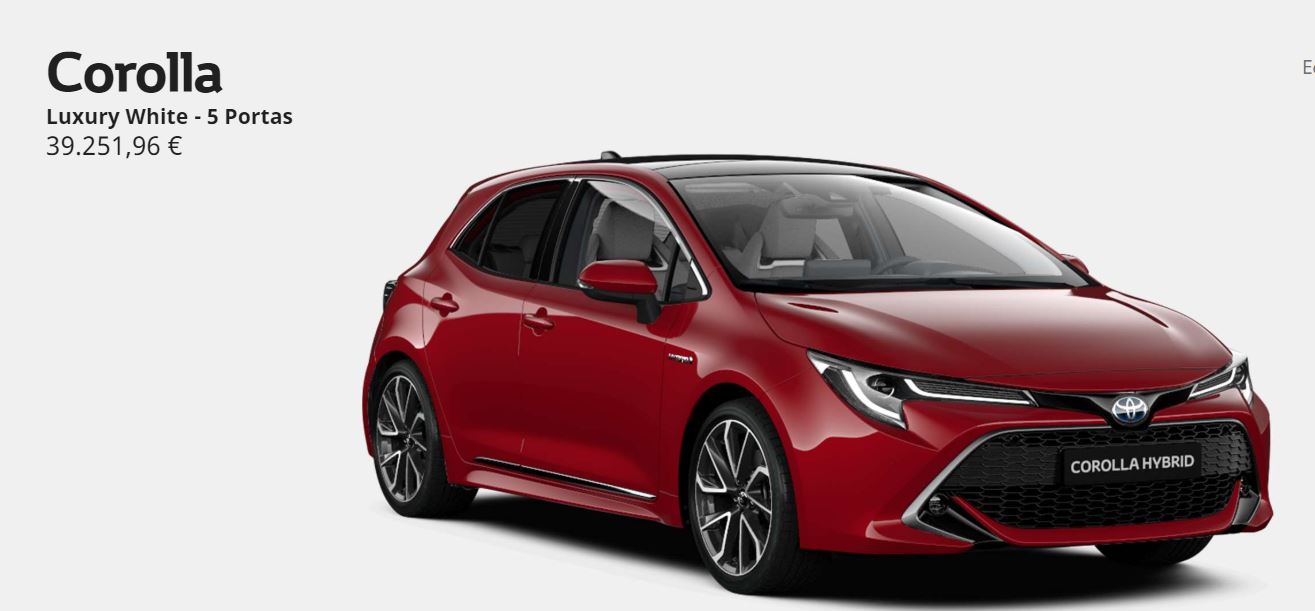
I'm really trying to don't get a test drive because I really want a plugable car (and I bet I would fall in love for this) but this car is just amazing!
Lexus can really build something special for the second generation CT.
And just look at it:

I'm really trying to don't get a test drive because I really want a plugable car (and I bet I would fall in love for this) but this car is just amazing!
Lexus can really build something special for the second generation CT.
larryren
Follower
- Messages
- 124
- Reactions
- 227
Greeting everyone. The ChDM version 12th Gen. Corolla haven been launched by FAW-Toyota at 9th August in Beijing.
Pricing starting at 119,800 RMB to 159,800 RMB
Pricing detail at below and trim level name are directly translated by Chinese [exchange rate 100 USD≈706.12 RMB]
First the gasoline version.
1.2T "Pioneer" ¥119,800 (US$ 16965.95)
1.2T "Elite" ¥127,800 (US$ 18098.91)
1.2T "Luxury" ¥135,800 (US$ 19231.86)
1.2T "Sporty" ¥136,800 (US$ 19373.48) [this version will get 17inch wheel and exclusive parts for it name ]
1.2T "Flagship" ¥145,800 (US$ 20648.05)
And the hybrid version.
1.8H "Pioneer" ¥135,800 (US$ 19231.86)
1.8H "Elite" ¥143,800 (US$ 20364.81)
1.8H "Flagship" ¥159,800 (US$ 22630.71)
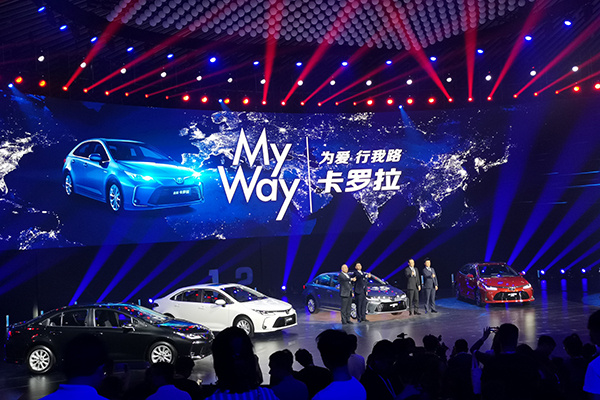
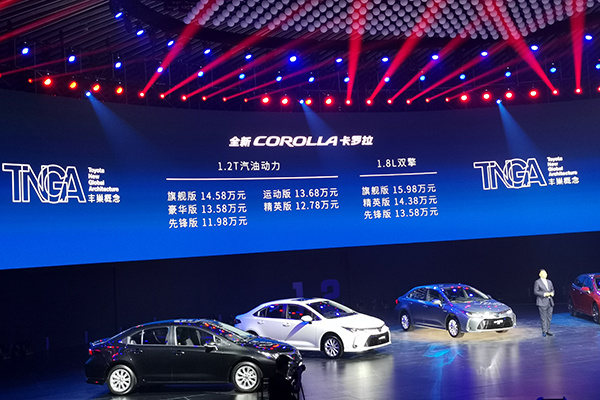
The pricing gap between Levin and Corolla is not so big. Also it just little bit different trim configuration between “its brother” GAC-Toyota's Levin. FAW-Toyota more focus on rear seat experience and TSS system(All trim provided, Levin not provided at lowest trim) and GAC-Toyota more focus on LED headlight and Rear seat 6/4 split folding. Some mid/high trim at Levin will provided parking radar.(Not provided for Corolla all trim.)
Also FAW side got pretty know Chinese consumer what they want to have. Such as leather seats, rear row AirCon outlet and USB chaging ports. Previously mentioned thing are only available in the top trim at Levin. But you can find it on Corolla gas version "Lexury" and both version top trim. And Corolla's name have better brand recognition in China since 2004. I think it will giving a big challenge for “its brother” GAC-Toyota's Levin. Even Levin launched the market two months earlier and last month sales reached 21771 units it have 24% year-on-year growth.
Pricing starting at 119,800 RMB to 159,800 RMB
Pricing detail at below and trim level name are directly translated by Chinese [exchange rate 100 USD≈706.12 RMB]
First the gasoline version.
1.2T "Pioneer" ¥119,800 (US$ 16965.95)
1.2T "Elite" ¥127,800 (US$ 18098.91)
1.2T "Luxury" ¥135,800 (US$ 19231.86)
1.2T "Sporty" ¥136,800 (US$ 19373.48) [this version will get 17inch wheel and exclusive parts for it name ]
1.2T "Flagship" ¥145,800 (US$ 20648.05)
And the hybrid version.
1.8H "Pioneer" ¥135,800 (US$ 19231.86)
1.8H "Elite" ¥143,800 (US$ 20364.81)
1.8H "Flagship" ¥159,800 (US$ 22630.71)


The pricing gap between Levin and Corolla is not so big. Also it just little bit different trim configuration between “its brother” GAC-Toyota's Levin. FAW-Toyota more focus on rear seat experience and TSS system(All trim provided, Levin not provided at lowest trim) and GAC-Toyota more focus on LED headlight and Rear seat 6/4 split folding. Some mid/high trim at Levin will provided parking radar.(Not provided for Corolla all trim.)
Also FAW side got pretty know Chinese consumer what they want to have. Such as leather seats, rear row AirCon outlet and USB chaging ports. Previously mentioned thing are only available in the top trim at Levin. But you can find it on Corolla gas version "Lexury" and both version top trim. And Corolla's name have better brand recognition in China since 2004. I think it will giving a big challenge for “its brother” GAC-Toyota's Levin. Even Levin launched the market two months earlier and last month sales reached 21771 units it have 24% year-on-year growth.
Last edited:
mikeavelli
Moderator
- Messages
- 7,490
- Reactions
- 16,632
I was reading an article about manuals and seems the sedan has a manual 1% take rate but the hatch 15%!
Tragic Bronson
Expert
- Messages
- 3,162
- Reactions
- 3,783
I was reading an article about manuals and seems the sedan has a manual 1% take rate but the hatch 15%!
Toyota manual transmission sales are minuscule — here are the numbers - Autoblog
It's automatic for the people.
Lights Turned Down on 2020 Corolla Family with Nightshade Editions
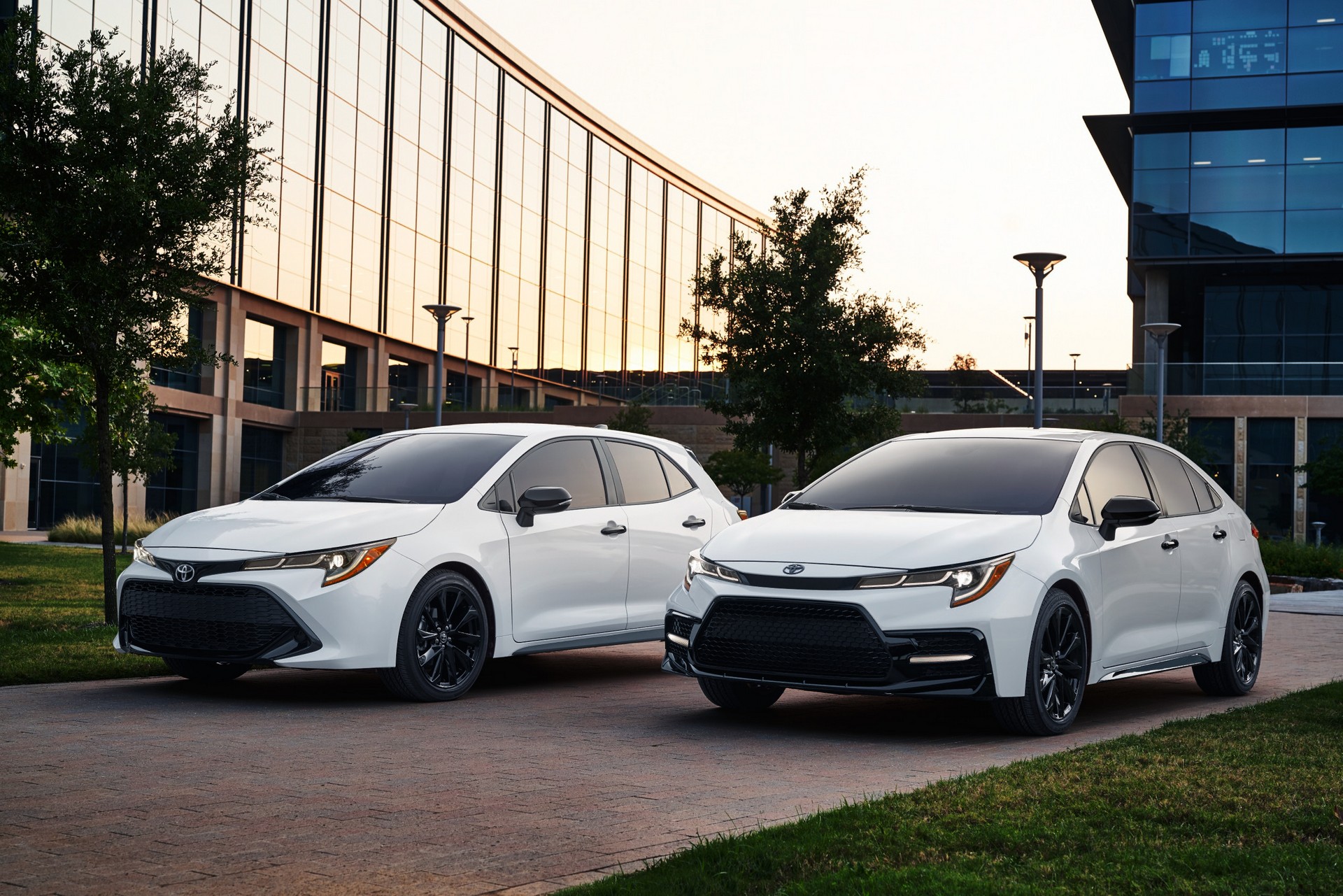
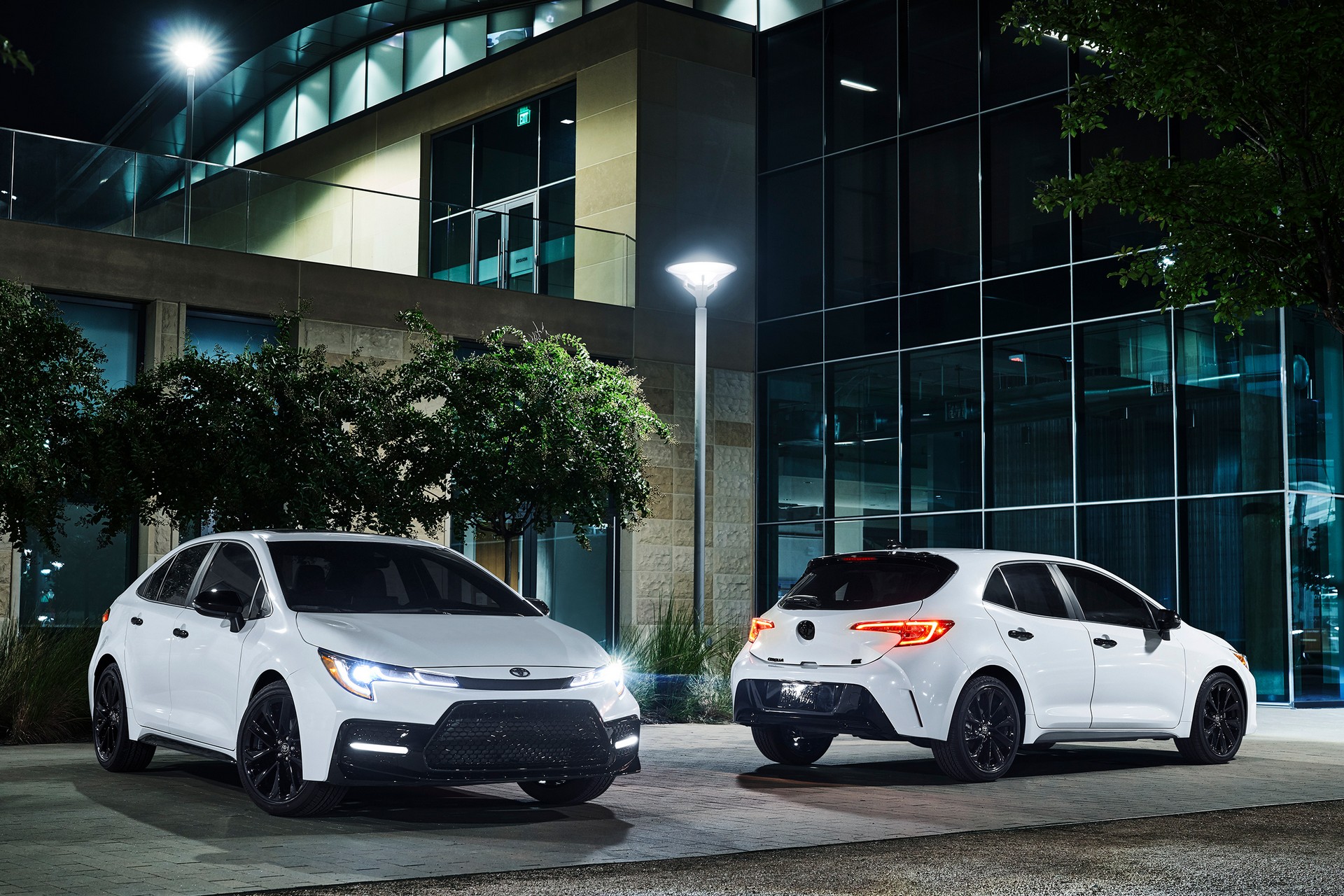

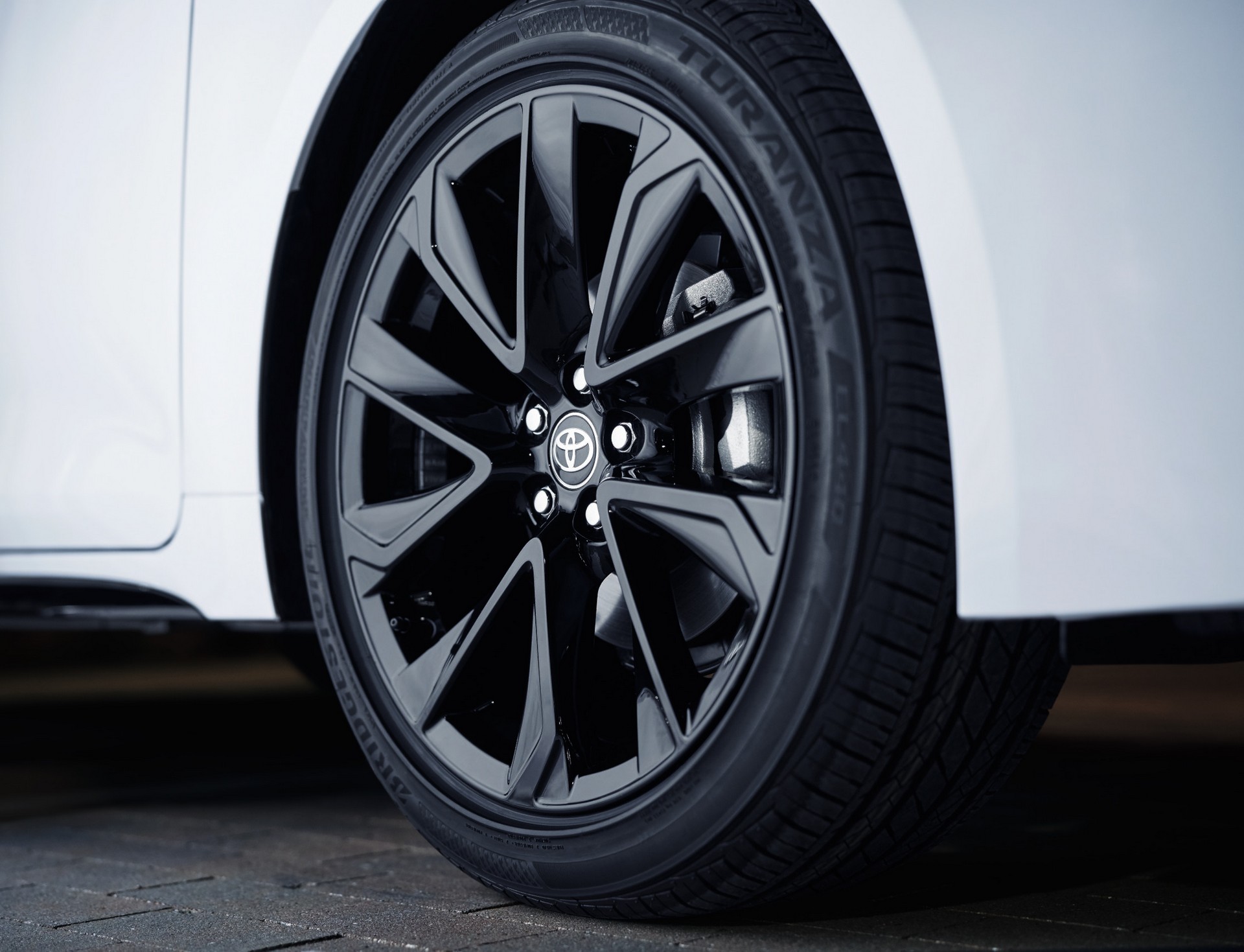
Looks good, but a proper performance model would be nice.
The sleek new Toyota Corolla and sporty Corolla Hatchback are getting the Nightshade treatment, as the special editions have been added to the grade lineup for model year 2020. Toyota now offers the Nightshade Edition package on six vehicles, with 4Runner, Camry, Highlander and Sienna already on sale.
The Sedan Goes Dark
The all-new 2020 Corolla sedan was introduced earlier this year with a new grade strategy, bold exterior styling and a sleek, driver-focused interior. Six months later, Corolla is getting a Nightshade Edition based on the SE grade with a CVT, with production starting this fall.
The Corolla Nightshade will feature blacked-out Toyota, Corolla and SE badging. The front will include a black grille surround and black-painted rocker panels, while black heated power outside mirrors with turn signal indicators, black window trim and black outside door handles will adorn the side. The rear will feature a black spoiler and lower diffuser area.
Blacked-out 18-inch alloy wheels and a black roof-mounted shark fin antenna complete the Nightshade package. Available colors include Super White, Classic Silver Metallic and Black Sand Pearl.
The Corolla sedan Nightshade Edition will have an MSRP of $22,750.
An Even Sleeker Corolla Hatchback
The Corolla Hatchback has been turning heads ever since its launch last year with its aggressive stance, 18” machined alloy wheels and the available Blue Flame exterior. Now the 2020 Corolla Hatchback will continue to attract attention with the sleek Nightshade Edition, which like its Corolla sedan sibling, is based on the SE grade with a CVT.
The Corolla Hatchback Nightshade will feature the same blacked-out 18-inch alloy wheels found on the Corolla Nightshade. It will have a black lower front rocker, black door handles, black mirrors caps, black side rockers, a black shark fin antenna, a black factory spoiler, a black rear lower spoiler and black rear exhaust diffusers. The headlamps with have a black headlamp inner frame and the Toyota and SE grade badging will be blacked out. Available exterior colors include Super White, Classic Silver Metallic and Midnight Black Metallic, while the interior will feature black fabric.
The Corolla Hatchback Nightshade Edition will have an MSRP of $22,290.
More Options for the 2020 Corolla Hatchback
The Corolla Hatchback was one of the first vehicles in the Toyota lineup to feature Apple CarPlay® compatibility, and for model year 2020 it will add Android Auto® compatibility as a standard feature to all grades. Additionally, SiriusXM® All Access Trial, previously an available option, will now be standard on both the SE and XSE grades.
A black roof, which has been available on the current generation Camry, now makes its way as an available feature to the Corolla Hatchback. It will be available with the following exterior colors: Blizzard Pearl, Oxide Bronze, Classic Silver Metallic, Smoked Paprika and Blue Flame.
The SE grade is also getting an enhanced cargo space option, which removes the spare tire and lowers the cargo floor, adding six cubic feet of cargo capacity. This available package will include a Tire Repair Kit (TRK) in lieu of a spare tire. This option will be available on both the CVT and 6MT SE grades.




Looks good, but a proper performance model would be nice.
-
This site uses cookies to help personalise content, tailor your experience and to keep you logged in if you register.
By continuing to use this site, you are consenting to our use of cookies.

